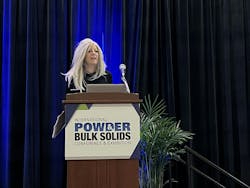Engineering Ethics Isn’t Optional — It’s Foundational
“With great power comes great responsibility.”
Summoning Spider-Man, Ursula Emery McClure, professor of engineering at Kansas State University, pointed out that Peter Parker’s uncle’s words should be relevant to all in the engineering profession.
“Ethics in engineering is a daunting responsibility,” McClure emphasized during her keynote address, The Weight of Responsibility: Ethics in Engineering, at the International Powder & Bulk Solids show in late April.
The "weight" is both literal and figurative. Engineers are expected to act not only with technical skill but also with a moral compass.
“Engineers are expected to exhibit the highest standards of honesty. Engineering has a direct and vital impact, requiring honesty, impartiality, fairness and equity — and must be dedicated to the protection of the public.,” said McClure.
Most importantly, she stressed, engineers need to care.
She pointed to the National Society of Professional Engineers (NSPE)’s Code of Ethics and broke it down to one fundamental question: Who/what are we caring for? She suggested five “Ps” to think of in your day-to-day work and how ethics plays a role in each:
• People
• Profession
• Product/Project
• Prosperity
• Protection of the plant
Unintended Engineering Consequences
As I listened to McClure’s keynote address, one example of an engineering unintended consequence immediately came to mind. The popular Keurig K-Cup coffee pod. The single-serve, disposable coffee pod invention is one such product that has had lasting impact on generations and the environment. Originally designed simply for office locations, its widespread popularity in households has resulted in an overabundance of plastic waste in landfills and the environment, and health issues for humans from microplastics leaching. Here are several other chemical inventions that also have had unintended consequences:
Scotchgard by 3M (perfluorooctane sulfonate or PFOS) – While 3M initially claimed the forever chemical was safe, studies showed it lingered in human blood and animal tissue, and high doses were toxic to lab rats. The proliferation of 3M products containing the compound has led to PFOS contamination in waterways and has been linked to human health issues.
Teflon from Dupont (Per- and polyfluoroalkyl substances or PFAS) — Like PFAS, this forever chemical first gained popularity for its ability to repel water, grease and oil, leading to its widespread use in non-stick pans and stain-resistant carpets. The chemical remains in production but is being phased out of many products due to the health risks posed to humans and the environment.
Ethyl (Tetraethyl lead or TEL) —The compound initially was heralded for reducing engine knock and improving auto fuel efficiency. While it was known to produce toxic lead, few thought of the consequences of lead buildup in the environment from vehicle exhaust fumes. By the 1980s, leaded gasoline was phased out of production.
Freon (chlorofluorocarbons or CFCs) — Freon was designed to replace hazardous refrigerants. However, its toxicity levels became a concern once it was introduced as a propellant for aerosol cans. The chlorofluorocarbons released into the air became ubiquitous, thinning the planet’s ozone layer.
RoundUp (Glyphosate) —The herbicide developed by Monsanto (now part of Bayer) for agricultural use worked so well at weed prevention that its use expanded to homeowner lawns and gardens. Since its launch in the 1970s, studies continue to link the weedkiller to numerous health issues in humans, including cancer, kidney and liver disease, endocrine disruption, and fertility and reproductive concerns.
McClure noted that engineers not only have to think about how what they design, build, and engineer fits their client’s or employer’s needs but also how it impacts people, ecosystems and future generations.
How to Apply Ethics to Engineering
“The most unfortunate thing about our work is unintended consequences,” she noted.
McClure acknowledged that building long-term foresight into the engineering design process is no easy feat, and engineers should not act alone — cross-disciplinary collaboration, communication and engagement with communities and stakeholders are necessary to distribute responsibility and create more ethical outcomes.
She urged engineers to resist systems that reward only “right answers.” Instead, engineers should think critically and embrace ambiguity, unintended consequences and the broader social, environmental and historical contexts in which their work exists.
To improve design and avoid unintended consequences, one must reflect, have engineering foresight and adopt ethical design strategies that involve working across disciplines throughout a product’s entire lifecycle, she shared.
“You have to consciously be keeping in mind that I need to make something that serves the immediate issue... and its long-term projection,” McClure advised.
“People look at the [engineering] profession as the paramount leader of contributing to the environment and making things that help humankind live and survive and be successful. And you want that reputation because it’s who you are, who your company is and whatever you make,” McClure stressed.
That reputation starts with civic responsibility and collaborating beyond the engineering profession. “When we care, we want to be good citizens of that world... our expertise needs to be shared,” she said.
Take a Look Around You
McClure noted that it’s important for engineers to stay humble, listen to others and expand one's perspective to see how a design impacts the world around them.
As we have been reporting in Chemical Processing, regulatory oversight in the chemical industry is loosening, and the burden of ethical decision-making increasingly rests on the shoulders of engineers and their organizations. The industry must hold itself accountable. Now more than ever, we must choose to care — because the consequences of engineering decisions shape not just products, but people, ecosystems and futures.
About the Author
Amanda Joshi
Managing Editor
Amanda Joshi has more than 18 years of experience in business-to-business publishing for both print and digital content. Before joining Chemical Processing, she worked with Manufacturing.net and Electrical Contracting Products. She’s a versatile, award-winning editor with experience in writing and editing technical content, executing marketing strategy, developing new products, attending industry events and developing customer relationships.
Amanda graduated from Northern Illinois University in 2001 with a B.A. in English and has been an English teacher. She lives in the Chicago suburbs with her husband and daughter, and their mini Aussiedoodle, Riley. In her rare spare time, she enjoys reading, tackling DIY projects, and horseback riding.


